My 4 year old gelding was initially always nippy and on top of me. In this post, I explain how do you deal with a pushy horse and reclaim your space.
This is one in a series of many posts outlining Rudy’s training journey with me! Rudy is my first young horse. I got him as a 4 year old and he’s a grey gelding warmblood cross. In this post, I’m going to talk about his second week in training and the biggest issue we overcame: my horse is pushing me around all over the place!
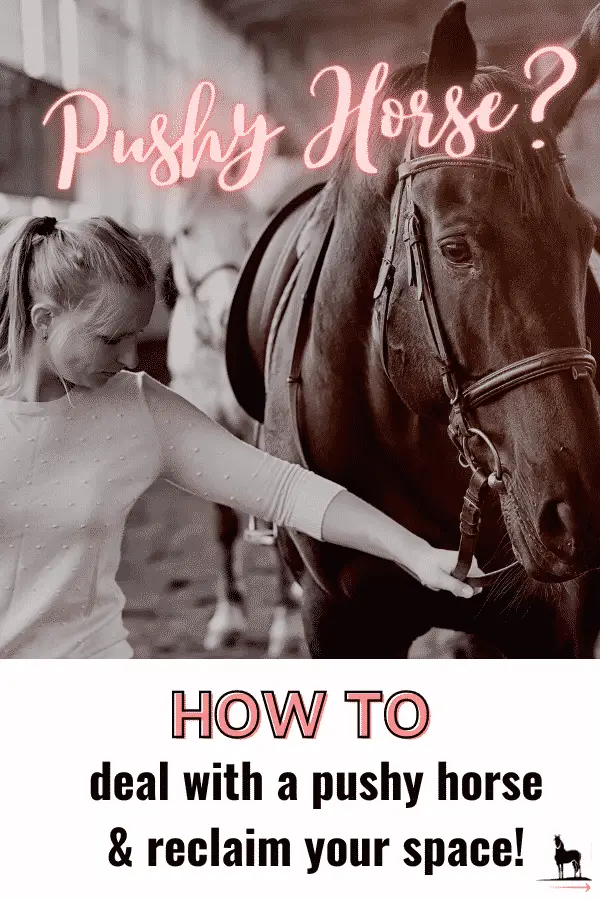
I watched quite a bit of Youtube videos but none of these really helped. The biggest thing that helped actually was calming my self and learning how to be present, focused and calm with Rudy in the arena. Initially I remember I would be hesitant and my mind would start racing…
“What if he runs over me…”
“What if I try and reclaim my space and he rears…”
“What if he charges at me…”
“What if he bites me…”
Learning to control my own thoughts, still myself and return to the present moment with Rudy made a huge difference because then I was responding to his actual actions rather than everything that was going on in my head. It also left space in my head to start focusing on positive outcomes and what I actually wanted to happen in each session and my body energy would start to reflect that.
I know that’s a little bit “woo-woo” so if you’re not into that, that’s fine! I just found it really helped me so I include a section on exercises that I did in order to calm myself in the moment below if you’re interested.
I know you probably don’t have a lot of time and you want to see if this post will help you asap (I’m the same way!) If you’d like to jump directly to how to fix a pushy horse, you can do so via the Table of Contents below. Just click on “How to Stop A Horse Walking Over You”.
I do share a lot of other things I found helpful with Rudy during his 2nd week in training and you might find some tid-bits of information that are interesting to you if you go through the whole thing!
Other Posts About Rudy’s Training Journey You Might Enjoy:
- Building A Young Horse Training Plan for Rudy
- Week #1: How Do You Teach A Horse To Accept A Bridle
- Week #3: [Coming Soon!]
If you’ve read last week’s post, How Do You Teach A Horse To Accept A Bridle, you’ll see how I came up with this week’s plan for Rudy’s training. I’ve re-copied this plan below under “Rudy’s Training Plan For Week #2”.
If you read my last post or read through any of my other training posts, it becomes obvious very quickly that these types of plans can fall apart very fast and often need to be changed day by day.
I always remind myself not to put any pressure on myself or Rudy to achieve the plan. It’s there as a guide so that I can be intentional about my training day but if things don’t go according to plan, it’s no big deal. I’ll shift the plan as I go according to what I see Rudy’s issues are in that day.
Rudy’s Training Plan For Week #2
1 hour/day for 4-5 Days/Week
Daily Plan:
- 5-10 minutes: Lunging
- 30-35 minutes: Grooming & Bridling
- 10 minutes: Free-Roam in the Arena/Rolling/Liberty
- 10 minutes: Leading & Exploring
DAY 1-3: My Horse is Pushing Me Around, Pawing, Nipping & Biting (While I struggle with the bridle…)
The first three training days, I followed my routine of bridling from last week:
- Lunge for 5-10 minutes in his halter and let him canter a bit if he wants to
- Working on lowering head until he can lower it immediately
- Work on head shyness until I can touch his face with my hand and with a softbrush anywhere
- Work on opening the mouth until he opened his mouth with his head down
- Bridling!
Unfortunately, the bridling was not successful until day #4 so the first 3 days I was mostly struggling.
Since we were spending so much time working on bridling in the isle, even with the lunging first sometimes Rudy would get restless. At certain points he would push into me and then paw in such an extravagant manner that I would need to move in order not to be hit.
The first week I had him, he was also very mouthy, which I wasn’t too concerned about but in the second week, this started to turn into frank nipping and bitting.
The real issue, however, would be in the arena lunging at the beginning. Whenever we’re lunging on the halter in the arena, Rudy would start to push into me a lot with his shoulder. Specifically when he would head up to the far side of the arena, he would drift inwards towards me. Eventually, he started to find ways he could get out of going that way completely by stopping, turning inwards and walking into me with his left shoulder (when he should have been on the right rein, if you can visualize that).

I wish I had some videos of what he would do because a lot of smart horses probably figure this out at some point even if they’re not necesarily pushy and don’t push into you. But I feel like it’s pretty common for horses to stop randomly on the lunge and then spin in the other direction to avoid moving forwards.
I like focusing on one big task at a time.
I didn’t deal with this immediately because I really wanted to focus on one thing at a time and for me that was bridling.
The only thing I did consistently during this period was mark every behavior I didn’t like with a quick “ah-ah”. Sometimes this worked to break Rudy’s anxious stream of thought and he would stop but a lot of the time it didn’t work. I guess to my way of thinking, I believed that he had built up anxiety that he couldn’t cope with himself leading to these behaviors. At least that’s what it felt like to me.
In the back of my head, I knew that after I dealt with the bridling, this had to be the next priority. Part of my strategy though was to use the work in hand and the stretching (I talk about this in How to Calm an Anxious Horse if you’re not familiar with it) so I knew that I had to get the bridle on to do that big portion of the work.
Update!
Since writing this post, I’ve learned a LOT more new ways to deal with anxiety that don’t involve anything and you can do with your horse just in his paddock. I’ve started doing this with Rudy and talk about it during a later training week: [Link Coming Soon!]
I would suggest if you’re dealing with these behaviors in a horse that is young to not try to get the bridle bit first like I did.
I think it’s probably much better to try to get the anxiety bit under control and then proceed to bridling. I don’t think Rudy would have had nearly as many issues with the bridle if he hadn’t been so anxious.
DAY 4: Bridling Successful, Nervous About Far End of the Arena
Finally on January 29th, 2021, I was able to smoothly bridle Rudy. The best part about this was that after that day, I didn’t really have any issues again (other than when I first started riding him because it turned out he had an ulcer on his inside left cheek but this was quickly resolved and I was still able to get the bridle on – I just could tell something was wrong).
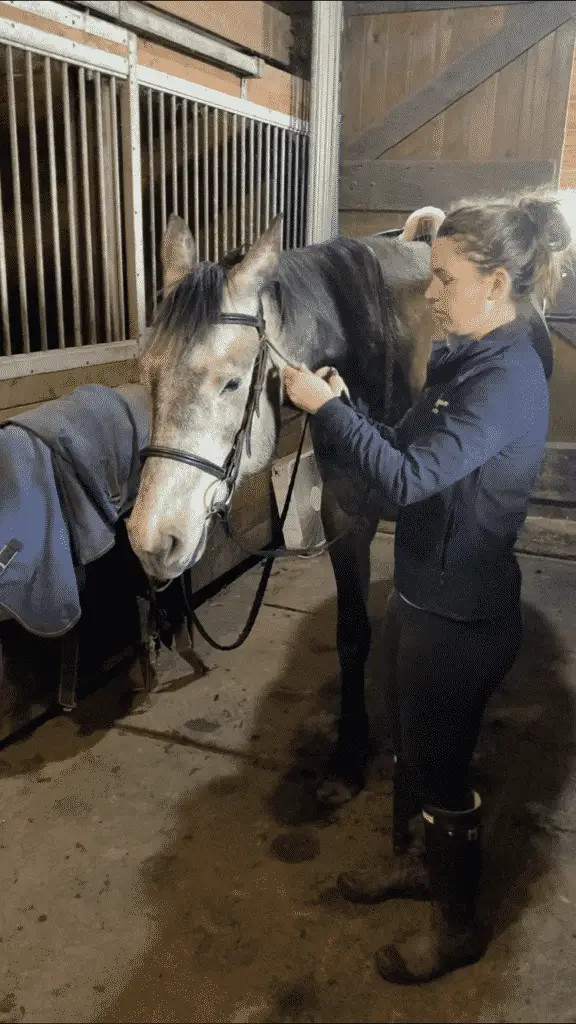
After I got the bridle on, I just led him around the arena in the bridle and then called it a day after that.
One of the lessons that I learned during week #1 of Rudy’s training is that it’s good to end on a good note.
So, although I could have proceeded to do some work with Rudy in his bridle (like work in hand or lunging) I didn’t. I decided instead just to lead him around the arena so that it was on for a few minutes and then I took it off of him.
While I was lunging on day 4 prior to my typical bridling routine, I noticed again that Rudy was wary of the far end of the arena. This is why he kept buckling inwards towards me (or stopping all together) whenever he was heading in the direction of the far side. This is also why I wanted to lead him around the arena once the bridle was on rather than leading him outside let’s say.

Staying Mentally Prepared For Anything And Expecting Nothing.
Given the success we had with the bridle, I wanted to now start tackling the far end of the arena. At the time, I obviously didn’t know that Rudy wouldn’t give me issues with the bridle again but I was hopeful that I could at least spend less time on it.
I was fully mentally prepared to go right back to the previous plan if bridling proved difficult again.
I find that it’s useful to mentally prepare yourself for anything your horse might do during training sessions because that way you’ll never get frustrated. If you have too many expectations of your horse (or really any expectations of your horse), you’re putting yourself in a position to become frustrated really easily.
This can damage the process of connection and bonding with your horse as they’ll sense your frustration towards them and your negative energy.
When we’re training, we have to remember that our horses don’t have the capacity like humans to “plot” or “plan” against us. I’ll talk about this more under day 5 when I talk about Rudy being pushy with me.
DAY 5: Being Pushy In Response to Anxiety
Again, Rudy was being very pushy with me. When I was lunging especially, he would continue to buckle in and lean his shoulder into my space when heading towards the far end of the arena. Furthermore, when I was doing work in hand with him he would spook again and again at falling snow from the roof. You can read my post on How to Calm an Anxious Horse or directly check out Will Faeber’s explanation at Art2Ride.com (he’s an expert on it!) for information on work in hand.

I could tell he was generally worried about a lot of different things in the arena. I know a lot of people think that my sensitivity to Rudy’s thoughts are over-kill. A lot of people in the horse community overlook spooking and think it’s better to pay no attention to it. I agree that after it happens, the best thing to do is nothing and keep going with your regular training.
What I do think, however, is that a lot of spooking even if it’s small is generally a sign of a horse that’s not relaxed (obviously). But I do think that concious efforts should be made as PART OF THE TRAINING to foster relaxation and peace.
I read somewhere that when horses are being pushy with you, it’s often because they are reverting back to their “baby brain” so to speak. They’re “on top” of you and pushing into you because that’s what foals do with their mothers when they’re nervous about their environment or when they’re seeking comfort.
A lot of people who think about pushy horses think about horses being “disrespectful” and start looking for almost punitive exercises or groundwork for disrespectful horses. It can be easy to think this when your 1000lb horse is all over the place and pushing you around, but the thing is they don’t understand how much bigger they are than you.
“Signs of A Disrespectful Horse” And Why I think This Statement Doesn’t Make Sense
Horses just don’t have regions of the brains that humans do when it comes to “plotting” or “planning” things. They can’t be direspectful because they don’t even understand what that means. Horses just react to their environemnts and their body expresses immediately their thoughts and emotions. There’s no filter there like there is with humans. Horses never have an agenda with us.
If something makes a horse nervous, unsure, uncomfortable or feel unsafe, they’re going to try to make themselves safe again.
Our job when were in training with them is to figure out how to make them feel as comfortable and safe with us as they do out with a herd of horses. This means we have to start learning how to “speak horse” in a sense and facilitate a sense of relaxation in them. If you’re interested in learning more about this, I go into detail how to do this until you can literally address any issue with your horse in my course: “Ground-Up Horsemanship”.
So, if you were wondering “how do you teach a horse to respect you”, try reframing this into “how to make a horse as rrelaxed and happy with you as possible”.
This shift in mindset alone can be INCREDIBLE for results.
Remind yourself that your horse is never purposefully trying to be difficult. They’ve got no hidden agenda. They’re just reacting to exactly how they feel and what they’re thinking in that moment. Pushy behavior often comes down to anxiety.
Of course, safety is priority #1. Make sure that you’re putting your safety before everything else. If your horse is being so pushy that they’re literally moving you around with their body and knocking you over, that’s an unsafe situation. If I was in that situation, I would take myself out of it and do a lot more work in a situation where I felt safe before going back (maybe with a fence in between you and the horse or in crossties).
How To Stop A Horse Walking Over You in 3 Steps
So, back to Rudy! After 5 days of training in week 2, I realized that my next challenge with him was to make him feel more comfortable around me and in the arena.
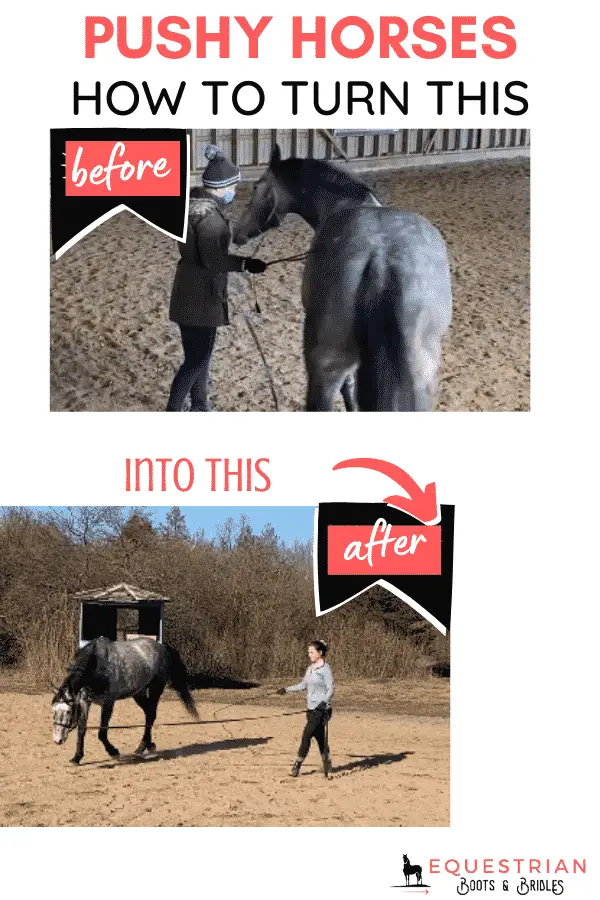
I trully believe that 2 things that were making him pushy were anxiety about the arena (especially the far end) and anxiety about me. It’s not that he was afraid of me, but he wasn’t secure enough just with my presence like he would be with other horses. He felt the need to constantly be pushing me so that I could make him feel safe and reassured.
This might be a controversial way to look at it, but it’s really what I believe is happening with pushy horses.
Either way, I know that when I started doing things to make Rudy feel more comfortable with me and in the arena, the pushiness stopped so if you’re dealing with this issue, it’s at least worth a try!
Step #1: Letting The Horse Figure Out Their Own Anxiety
First thing that I did was that I changed my training plan (again!) I simply added in “free time” at the beginning of the session. This way, Rudy would get to explore the arena before I started to work with him.
I noticed that by the end of our training sessions, when he got to roam around he was slightly calmer. Initially, I thought this was just because he got some energy out when I was lunging him, but I think now that it had a lot more to do with the fact that he was able to explore this unfamiliar place on his own terms. It was easy for me to forget that it was only his 2nd week there and a lot of time was spend in the stable isle working on bridling rather than in the arena.
By including 10-15 minutes at the beginning of training for free-roaming, I was letting Rudy figure out his own anxiety. Interestingly enough, within a few minutes, he was slowly creeping up to the far side of the arena all on his own whereas when I was trying to apply pressure to get him there while he was on the lunge line, he would promptly refuse.
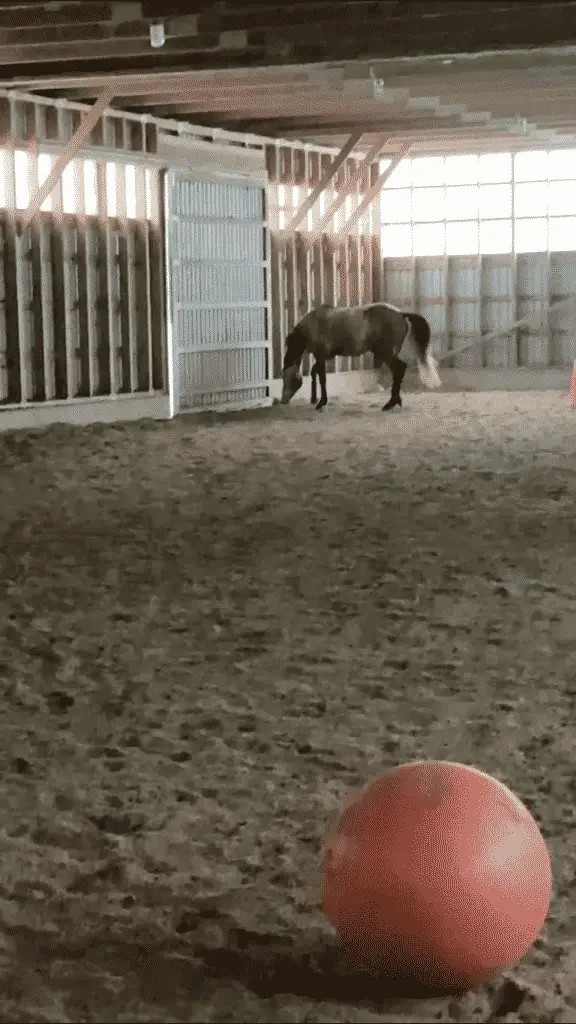
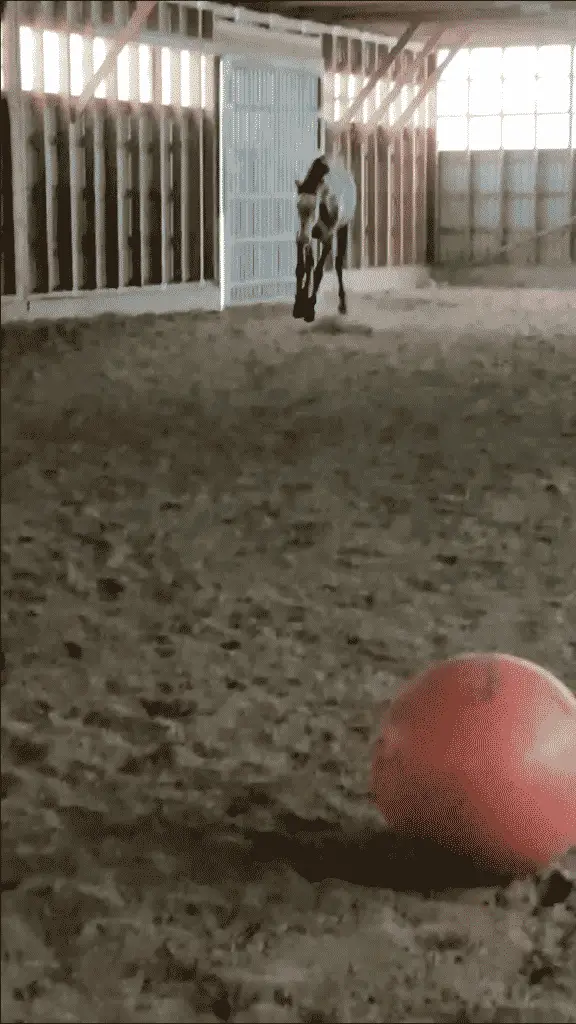
From what I’ve observed, horses are extremely curious. But they have to feel safe exploring and me applying pressure for him towards something he was unsure about was just too much for him. It’s not that he was being disrespectful or that he was trying to be “dominant” over me. He was trying to tell me that he just didn’t like it over there and I wasn’t providing enough of a safe presence to make him feel comfortable about it.
I’m boarding Rudy so I can’t do this but if you have your own arena, you can even just leave your horse in there for an hour or two before you work with them with some water. That way, they can explore and just get really relaxed and confident about the space.
Step #2: Changing The Horse’s Rest Spot
A huge factor I think that was also coming into play was not just that Rudy was unsure about the far end of the arena but also that he was constantly trying to get me back to the entrance to the arena towards the barn. He knew that going through those doors meant going back to his friends in the paddock, eating and resting.
He was pushing into me trying to get to a place where he could rest.
So what I did was that I purposefully always made his rest spot as close to the far end of the arena as possible. Whenever we were lunging, I would down-transition or ask him to halt at the spot where he was facing the far end.
Whenever we were doing work in hand, I would switch sides or I would just take a break when we were at the closest point to the end of the arena.
Pretty soon, we were doing circles at the top end of the arena!
Step #3: 2 Tricks To Teaching A Pushy Horse Ground Manners
These were the two things that made a difference immediately!
There are two tricks that I used to completely change the way that Rudy and I interact with eachother on the ground. One of them was taught to me by one of the owners of the barn where I board Rudy at and the other I watched in a video by Warwick Schiller.
At this point, I knew I was dealing with the environmental anxiety by giving Rudy time to explore the arena and by showing him that he actually gets to rest closest to the scary part of the arena so that he’s more drawn to it. I was also dealing with Rudy’s general state of anxiety by communicating to him that I saw his anxiety on a regular basis. As I mentioned above, you can read more about this in my post: How to Calm Down An Anxious Horse. I also go into a lot more detail on communicating clearly with horses in my course “Ground-Up Horsemanship.”
What I still needed to deal with was deliniating my bounderies. This was important for my own safety and also it would put Rudy in a situation where he would be forced to figure out his own anxiety and worry instead of leaning on me all the time. This is kind of like me or you sitting with a hard emotion (like anxiety!) and dealing with it instead of immediately trying to numb it by turning to something external like reaching for a glass of wine or a tub of Ben & Jerry’s.
Trick #1 – Using Your Hands & The Lunge Line (Or Whatever Else You Have) To Create Energy
This trick is invaluable when lunging. I’m probably going to write an entire post just about this! I’m so happy that one of the owners of the barn I board at showed it to me.
As an aside, I know a lot of people hate being offered help when they’re struggling with their horse but I literally LOVE IT when people offer to help me. I mean, there’s the odd day where I’m in a mood but when that happens, I remind myself to LOVE IT (haha). I’m far from a horse expert so I want to learn as much as possible from whomever I can!
So for this, what you do is whenver the horse comes into your space at all, you want to put both your hands as high as you can towards your horses face and wave the coiled end of th lunge line in their face and create as much energy as you can in order to send them away.
This won’t work if you’re too timid about it. You really need to make yourself big.
Try to avoid moving YOUR feet. The idea is to get YOUR HORSE’S FEET to move around you when you’re lunging or away from you if you’re just trying to create some space.
If your horse is free in the arena or in a round pen and for whatever reason they’re getting too close to you or you’re worried about them running into you or over you, you’re going to immediatley put both hands up towards they’re face and wave the end of the lunge (or a flag or a lunge whip) at they’re face to create energy.
This not only kept Rudy’s shoulder from buckling into me, but it also helped with moving him forwards with energy around me and it worked like a charm when he tried to stop and turn into me or turn the opposite way and run into me with his shoulder.

Trick #2 – Using The Finger Push (Also works really well for horses that bite!)
This method is useful if you’re grooming or doing something else where you want to be fairly close to your horse but your horse keeps pushing their head into your space all the time.
Keep in mind that your horse literally might just want to interact with you. So you can try to just craddle their muzzle and play with their face a little bit first to see if that kind of satisfies them.
If they’re being mouthy or biting though or overlly pushy, it’s a safety issue so you need to get their head away from you. For Rudy, I had to use this a lot to get him from biting me initially. He was extremely mouthy and when he became anxious about someting (or excited) it would change from interaction and playful nibbling to frank biting.
What I did was put my index finger and push with even pressure right on his TMJ until his head was straight in front of his body. Typically when you’re first starting to do this, you’ll need to do it MANY times before it sticks. I think the first time with Rudy was 8-9 times. After the last time, he started yawning, dropped his head and just relaxed!
Pretty cool, eh?
Lessons Learned from Rudy in Week #2
I like to keep a log of the lessons that I learned each week from Rudy.
Hopefully you’ll find them useful too!
- Keep calm and stay present.
- There’s no point trying to get a horse to respect you or assert your dominance through corrective exercises. It’s much more useful establishing a solid line of communication and making your horse feel safe and comfortable. The leader of a herd of horses (aka the most dominant) is the one most responsible for the safety of all the other horses.
- Have no expectations and be mentally prepared to go backwards as many times as necessary.
- Horses can deal with their own anxiety if given the opportunity. They don’t always need to be pushed towards a scary situation by us.
Rudy’s New Training Plan For Week #3
1 hour/day for 4-5 Days/Week
Daily Plan:
- 10 minutes: Exploring Arena
- 15 minutes: Forwards/Backwards & Lunging in Halter
- 15 minutes: Grooming & Bridling
- 10 minutes: Connection & Liberty
- 10 minutes: Leading Around Property & Exploring
Keep reading on for Week #3 -> [Coming Soon!]
More Posts You Might Enjoy…
- Building A Young Horse Training Plan for Rudy
- Week #1: How Do You Teach A Horse To Accept A Bridle
- Week #3: [Coming Soon!]
Happy riding,
Martina
Like this post? Why not share it:


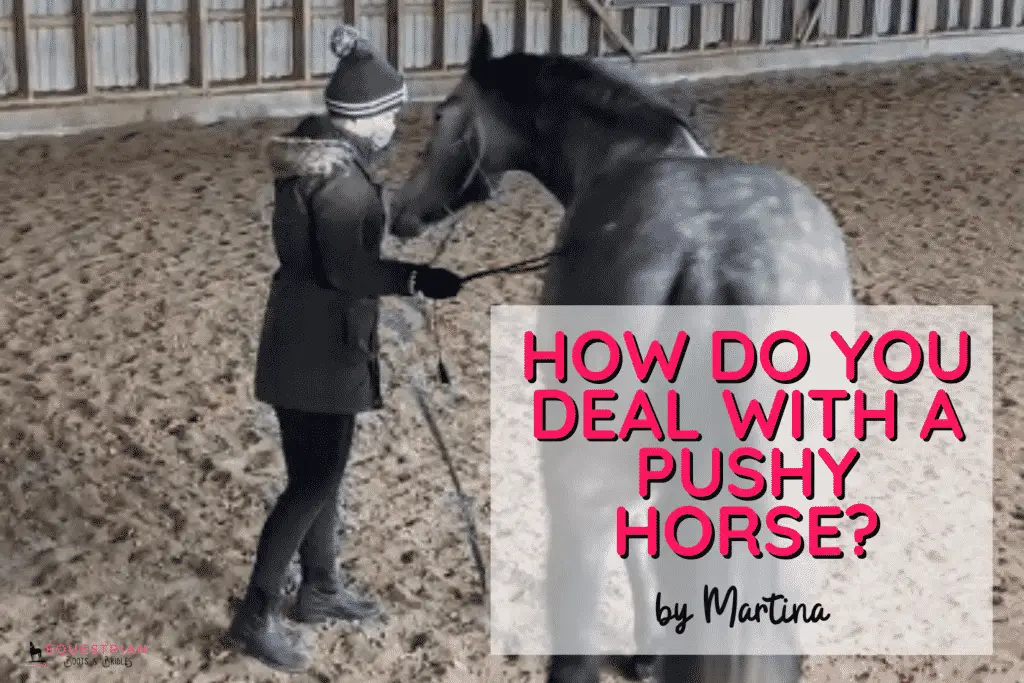


Hello my name is pia and I have taken only a few years of horse back riding lessons when I was only about 12 years old, I’ve never tamed a horse or trained any I truly have no experience. Long story short a family friend have recently purchased a 3 year old horse and there is a small expectation from me to help tame the horse since the owner is a 80 year old man. This article was the first of many I’ve tried to read and this by far is the closes thing to my current situation being that the horse you are training is as young as the one I have. I would really appreciate some 101 training if that’s even a possibility.